All about the picket fence
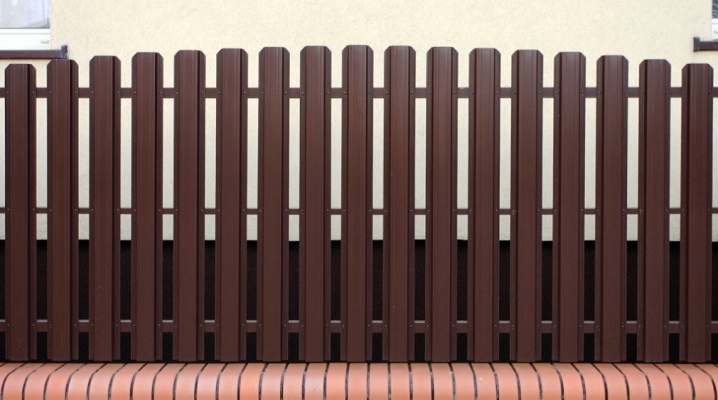
Questions about what it is a picket fence and what it is used for often arise from people who want to make temporary or permanent fencing of a plot of it only practical, but also attractive in appearance. This type of construction is especially popular in Europe, the USA and Canada, and in Russia it is most often considered as an option for a summer residence. An M-shaped plastic euro fence for a fence, wood-like models and other types of metal and slats are widely available on sale today, so it is worth considering them in more detail in order to make a choice in favor of one of the available options.
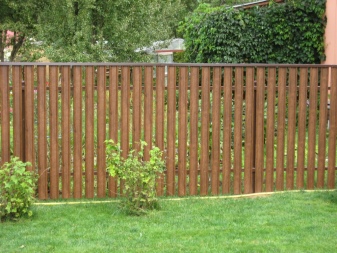
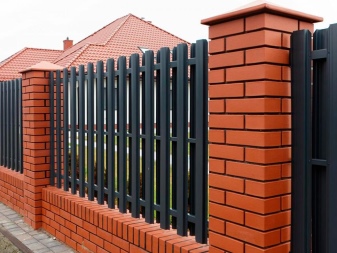
What it is?
Picket fence, Euro-plank, metal picket - all these names usually mean the same type of fencing, which is not a solid structure. Instead of a solid canvas for spans, separate strips, one-sided or double-sided, are used here, fixed on the base - a frame made of pillars and horizontal load-bearing elements. The name "picket fence" comes from the German stake - a pillar or pole. Usually the planks are attached in a single row, forming a fence with equal gaps between the planks. There are also double-row structures in which on both sides of the horizontal guide there are pickets in a checkerboard pattern.
The main function of the picket fence is to mark the boundaries of the site, its role is more decorative than protective. In its classic version, such a fence maintains normal air exchange, does not change the microclimate of the site.
For a long time, the picket fence remained exclusively wooden, but today it is made from metal and polymer materials, as well as from composites in different versions.

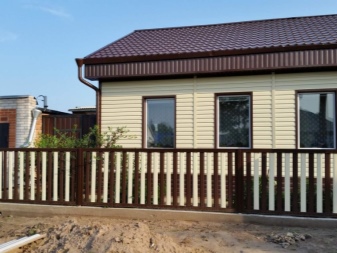
Advantages and disadvantages
Since the picket fence is a fairly common type of fencing, you can find both advantages and disadvantages in it. The obvious advantages include the following.
- Affordable cost. You can equip the fence structure without spending too much money.
- Possibility of self-assembly. It is possible to build a fence from a picket fence without long and complex preparation, concreting the base, laying the foundation.
- Harmonious appearance. Such a fence fits perfectly into any style of landscape design, suitable for summer cottages, urban and suburban real estate. The upper part can be designed in almost any shape: from semicircles to festoons, rhombuses.
- Wide range of materials. You can make a fence from plastic modules, metal or wooden strips, smooth or with different types of profiles.
- Maintainability. You can easily restore the integrity of the structure without dismantling the entire fence.
- Service life up to 5 years. The picket fence lasts longer; with proper care, the fence will have to be replaced in 10-15 years.
- Lack of difficulties in leaving. Wooden structures are periodically painted, metal structures are simple enough to wash, removing dust.
- Lack of solid shadow. Along the fence on the site, you can plant both shade-tolerant and shade-loving plants, form hedges.
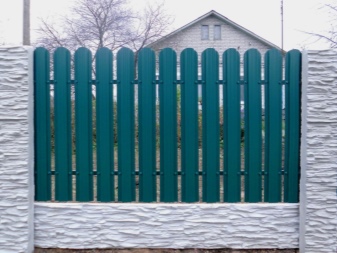
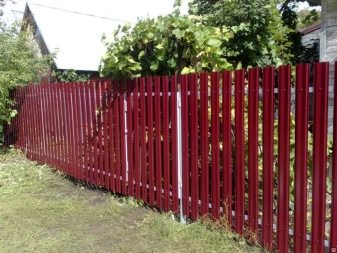
But not without drawbacks. In terms of strength and durability, it is noticeably inferior to capital fences. In addition, a picket fence with sharp edges is quite traumatic; if the site is located in a wind-blown place, it will not protect against weather disasters.Another significant drawback is the lack of privacy. It will not be possible to completely hide from neighbors' eyes.
Varieties
All existing picket options can be divided into types according to the established classification. The main division is made according to the type of staining, and it is relevant mainly for the euro shtaketnik. It can be one-sided, with a decorative layer applied only in the front part, and also two-sided. Exterior finishing is carried out using a polymer or powder composition.
In the one-sided picket fence, gray soil is used, with which the inner (unpainted) part is protected from adverse weather conditions.
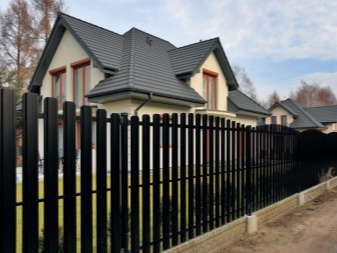
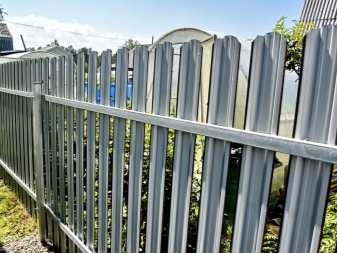
Polymer compositions are used in combination with other types of coatings. A primer must be applied under the decorative layer, often in several layers. Such a picket fence looks attractive and allows you to create bright multicolored compositions. When powder painting, a special dry composition is applied over the usual decorative layer, then the blanks are baked in chambers at a certain temperature. With full compliance with the technology, the fence is protected from almost any external influences, does not fade in the sun.
Manufacturing materials
Most often, the picket fence is classified according to the materials of manufacture. Moreover, on the market today there is a steel and forged euro fence, mini-PVC sections for decorating flower beds, wooden varieties and combined wood-polymer versions of such fences. Individual planks are made from different materials, but the frame is usually wooden or metal. Combined fences can use a brick and concrete base with separate inserts in the form of picket sections.
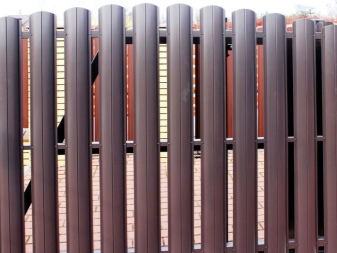
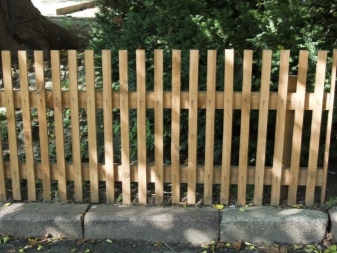
Plastic
Classic picket fence options are not made of plastic. But on sale you can find small PVC sections designed for framing flower beds, flower beds, flower beds... They are not very durable, last 1-2 seasons, quickly lose their bright color when in contact with moisture, sunlight. Among the advantages of such fences are the minimum cost, the ability to wash with water, and chemical neutrality.
Wood-polymer and PVC products are immediately available painted in the desired colors. Often they are decorated with natural wood, and the material itself is made of plastics that are resistant to temperature extremes. Visually, the polymer picket fence is no different from the traditional wooden counterpart. Its strips are 150-230 cm in size, fixed on metal brackets in grooves or with special brackets. To increase the strength, stiffeners are used, the upper part, if it has to be cut, can be covered with plugs.
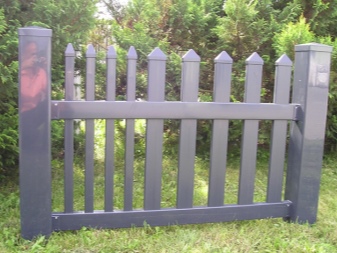
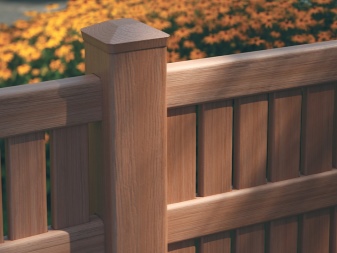
Wood-polymer composite (WPC) is also quite popular in the manufacture of picket fences. It is similar in composition to a terrace board, has increased strength and weather resistance. The material is made using a similar technology, is not inferior to wood in terms of rigidity, and always remains attractive in appearance.
There are cavities inside the plank to keep the structure light and rigid.

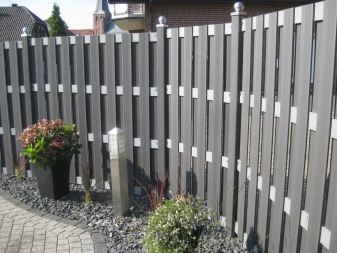
Metal
The picket fence made of metal is divided into 2 categories: profiled, made of sheet metal, and also welded, made of pipes of round, square, triangular cross-section. They differ in the way they are assembled in a section, in strength characteristics. Metal fences made of tubular picket fence are the most durable, can look very attractive, and go well with stone, brick and concrete. The profiled version is quite light, such a fence is erected without a foundation, just on supports, assembled with self-tapping screws and bolts.
Euroshtaketnik has a presentable appearance, can be mounted in 2 rows, staggered, blocking the view for prying eyes, and is available in various colors and design options.
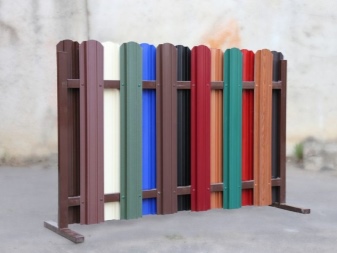
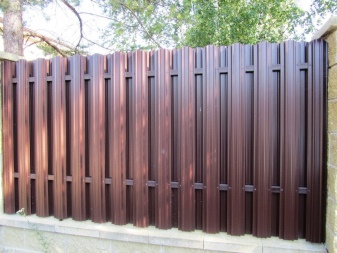
Wood
Planks made of natural wood are a classic that allows you to use both improvised materials and specially manufactured planks for fences. This type of picket fence can be short - 30-60 cm, it is used for zoning, and also comes in a standard height. Wooden picket fence can be painted, varnished, stained. Renewal of the decorative and protective layer is carried out once every 2-3 years. It can be carved or smooth, and the tops can be shaped like peaks, trapezoids or triangles.
Wooden picket fence differs from other types in the variety of installation. It is easy to lay it vertically and horizontally, fix it in a checkerboard pattern, fan-shaped, create unusual compositions. Inexpensive softwood is most often used as a material for manufacturing. It is important that it is well dried, without knots, chips, resin traces. The standard width of the planks is 20 mm, the length varies from 1100 to 2000 mm.
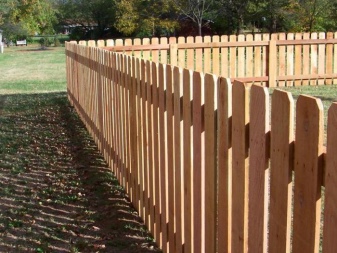
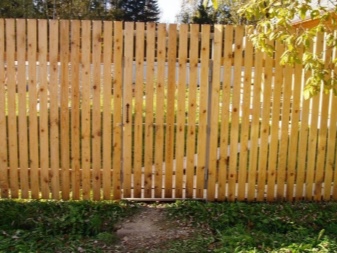
Shapes and sizes
This characteristic mainly refers to the Euroshtaketnik. It is characterized by a module thickness of 0.5 mm, a length of 1.5 m, 1.8 m, 2 and 2.2 m. The width, depending on the type, is 70-128 mm. The average weight of a product is 400-800 g per 1 running meter.
The following types of picket fence are distinguished by the type of profile.
- U-shaped. The simplest profile with painting on 1 or 2 sides. The wide one is additionally rolled along the side edges to extend the service life, impart additional rigidity.
- M-shaped. Shaped multi-ribbed profile with additional stiffeners. For him, they produce upper strips used for double-sided installation in order to provide the necessary decorative effect and strength. The end of the product is made straight or curly.
- Semicircular. The radius profile is the most durable, with fewer stiffeners. The round outer edge looks original and modern. Such strips are made with powder paint.
The finished products have a maximum service life of up to 20 years.
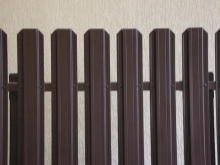
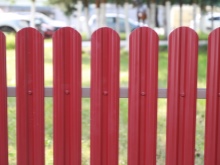
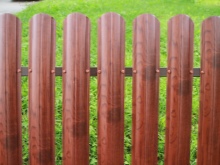
Color and design
The original design of the picket fence is mainly found in products that are decorated with a printed method. It can be used to apply patterns under a tree or under a stone on the surface of a metal workpiece. The finished fence looks very attractive, decorative strips are made in a one-sided version, gray soil remains inside. Wooden options are no less diverse - carving is used here, milling of material according to a template, after which the strips acquire a figured and very attractive appearance.
A modern decorative picket fence can have almost any range - RAL allows you to bring to life almost any design idea. Among the popular ready-made options, you can choose the Versailles and Country models with 3 and 1 stripes, painted in antique or golden oak. Monochrome coatings without imitation of wood texture are no less relevant. It can be Provence in pure white, gray, graphite, wet asphalt or classic brown.
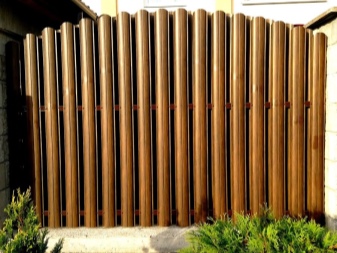

Top manufacturers
There are many manufacturers who make pickets in different designs today. There are several among the most popular firms and brands.
- "Maxiplast". Market leader for polymer picket fence. The company produces a wide range of garden fences in different colors and shades, high and low fence options for site planning.
- Hilst. The company produces planks made of wood-polymer composite. Original products have different profile shapes, colors and shades.
- TCEs. The Russian company that produces the Kroma euro shtaketnik.The company has established itself well, pays great attention to product design. The recommended service life reaches 30 years. You can find pickets made of galvanized steel uncoated, powder coated and polymer coated.
- "Eugene ST". The company produces metal profiles, siding and other products. Euro shtaketnik is produced under the Barrera brand in the Grande, Classic, Barrera 80 series with printed and polymer double-sided coating.
- Kronon. A company from the Russian Federation that has been successfully operating since 2000. The picket fence is produced under the Nova brand, the coating is aluzinc or polyester in a matte, glossy finish.
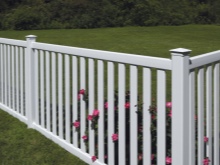
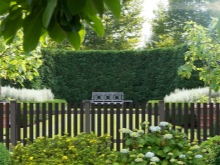
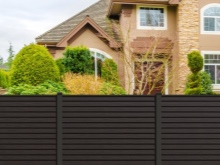
The list of brands is not limited to this. Many domestic companies, including regional manufacturers, have interesting proposals.
Criterias of choice
When choosing a picket fence for a fence, it is imperative to take into account certain criteria that will affect the further operational characteristics of the material. Among the important points, one can single out the price of products. Here natural wood will be the leader, for a running meter you will have to pay from 10 rubles. Plastic is inexpensive, but hardly surpasses wood in strength and practicality. The picket fence is the cheapest one-sided version.
When choosing the type of fence, the following points should also be taken into account.
- Appointment. At the dacha, you can choose a picket fence made of wood or plastic as a temporary fence. Metal elements are suitable for creating a capital fence for a private house.
- The rigidity of the structure. M-shaped and rounded profiles provide higher strength than U-shaped. It is worth paying attention to the fact that the latter option is cheaper, the least durable, most often has a one-sided coating.
- The height and width of the planks. It is worth paying attention to the fact that from the side of the street, a double-sided fence made of euro-fence with a height of 2 m or more is usually installed. range from 20 to 60 mm.
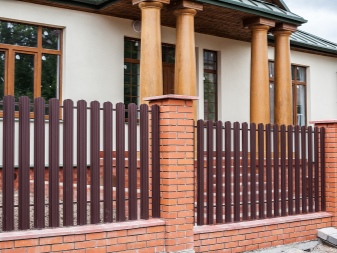
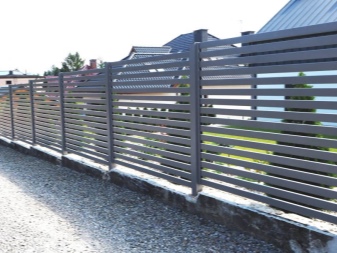
Considering these criteria, it will be much easier to make the choice of a high-quality picket fence for a home or a summer cottage.
Installation features
When installing fences from a picket fence, several important stages stand out, which cannot be dispensed with.
- Layout and preparation of the site. The position of the fence, the point of digging in the pillars, the length of individual sections are determined. Marking is carried out on the ground with twine. The number of strips is calculated (based on the fact that the gap between them cannot be greater than the width of the fence itself).
- Determination of the installation method. For the horizontal fastening of the picket fence, you will need a different amount of material than for the vertical one.
- Foundation laying. If the soil is not too loose, you can do without concreting by strengthening the pillars by laying rubble stone in the pit. In this case, the underground part of the support should be 200 mm on a pad of sand and crushed stone 100-150 mm. For concreting, you need a pit 80 cm below the ground level.
- Assembling the frame. It can be done by welding or by mounting horizontal elements with bolts. After that, all metal elements are painted to protect against corrosion.
- Installation of a picket fence on logs. The strips are fixed with special self-tapping screws, if it is a metal profile or wood, plastic is fastened with brackets, pipes are welded.
- Installation of plugs and decorative elements. Produced at the stage of final finishing.

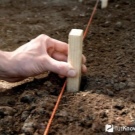

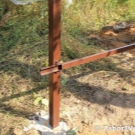
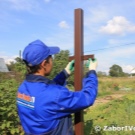
Depending on the type of picket fence, some installation features may vary. But the basic procedure is always the same.
Beautiful examples
- Lightweight polymer picket fence on a solid brick-concrete base. The fence is harmoniously matched to the color of the facade of the building, copes with its functions quite successfully, has a spectacular rounded shape of the upper edge.
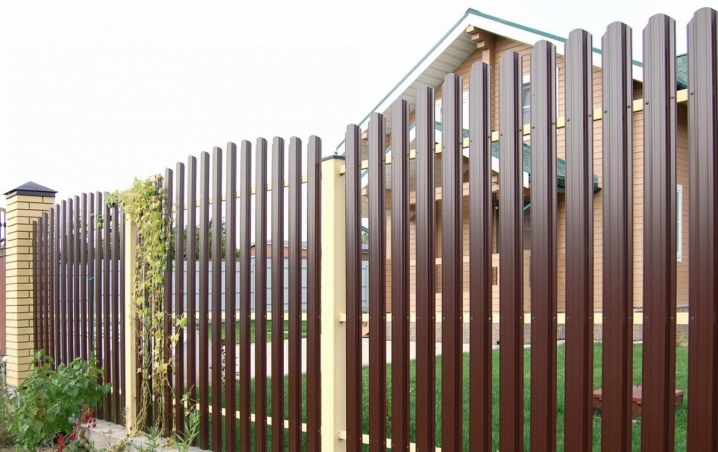
- Wooden picket fence with original stacking of modules. It does not look boring, it fits organically into the surrounding landscape. The two-sided construction eliminates the effect of "transparency" and makes the fence more comfortable for residents.
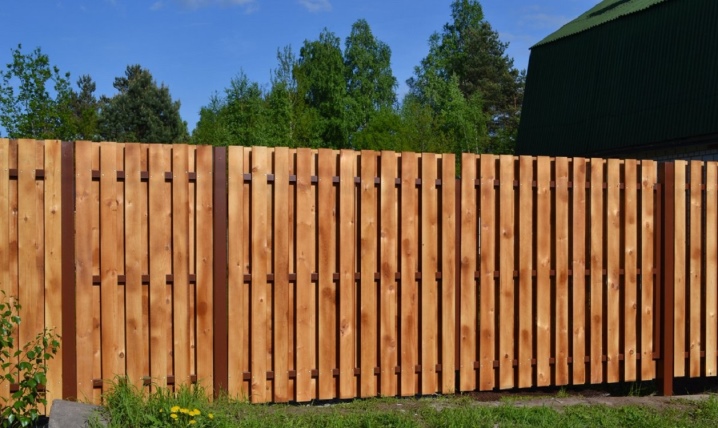
- An example of an elegant euro shtaketnik, combined with a brick base. The fence looks light, elegant and strict, while the area around the house does not look like a fortress.
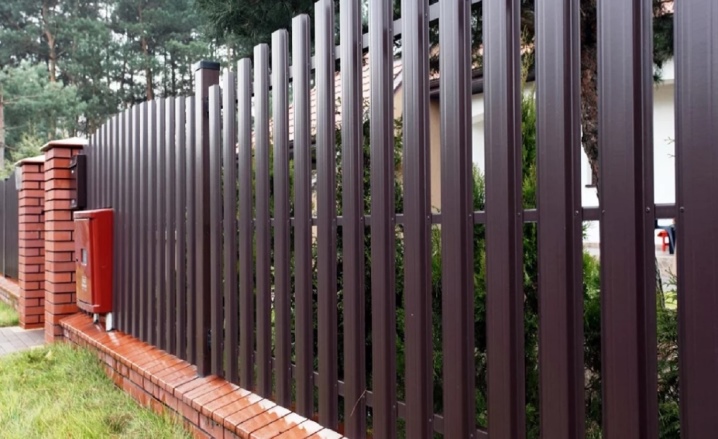
For information on how to make a picket fence, see the next video.



































































The comment was sent successfully.